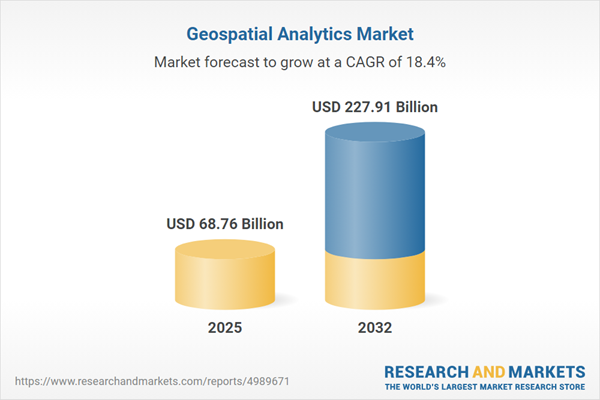Speak directly to the analyst to clarify any post sales queries you may have.
The geospatial analytics market is undergoing rapid evolution as organizations increasingly harness real-time location intelligence to enhance decision-making and optimize their operations. Senior executives must understand the latest industry dynamics, key adoption patterns, and strategic imperatives to maintain a competitive edge.
Market Snapshot: Growth and Opportunity in Geospatial Analytics
The geospatial analytics market grew from USD 58.83 billion in 2024 to USD 68.76 billion in 2025. It is projected to expand at a CAGR of 18.44%, achieving a value of USD 227.91 billion by 2032. This robust growth reflects sustained investments across sectors driven by expanding use cases, continuous innovation in data processing, and increased demand for actionable spatial intelligence to support organizational transformation.
Scope & Segmentation
This comprehensive report provides in-depth analysis, focusing on market structure, emerging applications, and segmentation drivers shaping the industry:
- Type: Geovisualization, Network & Location Analytics, Surface & Field Analytics
- Technology: Geographic Information Systems (GIS), Geospatial Modelling, Spatial Data Analysis, Remote Sensing
- Deployment Mode: Cloud, On-Premise
- Organization Size: Large Enterprises, Small & Medium Enterprises (SMEs)
- Application: Disaster Management, Earthquake Monitoring, Flood Prediction, Natural Resource Management, Forestry, Water Resources, Transportation, Logistics Management, Vehicle Tracking, Urban Planning, Infrastructure Development, Smart Grids
- End-user: Agriculture, Automotive & Transportation, Banking & Financial Services, Defense & Intelligence, Energy & Utilities, Government, Healthcare & Life Sciences, Logistics & Supply Chain, Mining & Natural Resources, Real Estate & Construction, Security
- Region: Americas (North America—United States, Canada, Mexico; Latin America—Brazil, Argentina, Chile, Colombia, Peru), Europe, Middle East & Africa (United Kingdom, Germany, France, Russia, Italy, Spain, Netherlands, Sweden, Poland, Switzerland, United Arab Emirates, Saudi Arabia, Qatar, Turkey, Israel, South Africa, Nigeria, Egypt, Kenya), Asia-Pacific (China, India, Japan, Australia, South Korea, Indonesia, Thailand, Malaysia, Singapore, Taiwan)
- Companies: Featuring coverage of 30 market leaders, including ALTERYX, Inc., Autodesk, Inc., Bentley Systems, Inc., Descartes Labs, Fugro, Google (Alphabet Inc.), Hexagon AB, Intermap Technologies, L3Harris Technologies, Maxar Technologies, Trimble Inc., and more
Geospatial Analytics Market: Key Takeaways
- Organizations in industries ranging from agriculture to logistics and public safety are integrating geospatial analytics to improve efficiency, enhance situational awareness, and drive innovation.
- Adoption of cloud computing, IoT networks, and machine learning is transforming how spatial data is processed and utilized, enabling scalable, real-time analysis.
- Real-time monitoring, edge computing, and advanced visualization tools—such as augmented reality—are redefining how field data is captured and acted upon, supporting resilient operations even in bandwidth-constrained environments.
- Small enterprises often seek rapid, simplified deployment, while large organizations prioritize customizable, end-to-end integrations to support complex, mission-critical workflows.
- Regional differences in infrastructure, regulatory context, and sector priorities demand localization of technology solutions and partnership models for successful market penetration.
- Innovation is further accelerated by mergers, acquisitions, and strategic alliances—specifically among software vendors, hardware manufacturers, and cloud service providers—expanding solution capabilities and competitive positioning.
Impact of United States Tariff Adjustments
Adjustments to U.S. tariff policy are adding complexity for geospatial analytics providers and their customers. Higher duties on imported hardware have led organizations to re-examine supply chains, accelerate domestic manufacturing, or adopt alternative components. Procurement and cost structures are now shaped not just by software and services, but also by logistics, compliance, and operational considerations. Strategic consolidation, local assembly, and new licensing models are emerging as providers and clients adapt to a changing regulatory landscape.
Methodology & Data Sources
This report utilizes a hybrid methodology, combining quantitative market modeling with qualitative interviews from domain experts and industry stakeholders. Rigorous validation against independent datasets and expert review ensures reliable, actionable findings for decision-makers.
Why This Report Matters
- Enables senior leaders to identify growth levers and innovation opportunities across the geospatial analytics value chain.
- Helps organizations optimize technology investment, resource allocation, and market-entry strategies by leveraging nuanced segmentation and regional insights.
- Provides actionable frameworks to navigate evolving supplier ecosystems, regulatory shifts, and strategic partnerships for enhanced resilience and agility.
Conclusion
Geospatial analytics continues to empower organizations with advanced spatial intelligence to solve complex challenges. Adopting next-generation solutions and adapting to evolving market dynamics will be crucial for maintaining sustainable growth and strategic advantage.
Additional Product Information:
- Purchase of this report includes 1 year online access with quarterly updates.
- This report can be updated on request. Please contact our Customer Experience team using the Ask a Question widget on our website.
Table of Contents
3. Executive Summary
4. Market Overview
7. Cumulative Impact of Artificial Intelligence 2025
Companies Mentioned
The companies profiled in this Geospatial Analytics market report include:- ALTERYX, Inc.
- AtkinsRéalis
- Autodesk, Inc.
- Bentley Systems, Inc.
- Descartes Labs, Inc.
- Environmental Systems Research Institute, Inc.
- Fugro
- General Electric Company
- Geoscience Consulting, LLC
- Geospin GmbH
- Google, LLC by Alphabet Inc.
- Hexagon AB
- Intermap Technologies, Inc.
- L3Harris Technologies, Inc.
- Locana Group
- Lockheed Martin Corporation
- Mapidea, Consultoria em Geografia S.A.
- MapLarge, Inc.
- Maxar Technologies Holdings Inc.
- Orbital Insight, Inc.
- Pitney Bowes Inc.
- Precisely
- RMSI Private Limited
- SAP SE
- Supergeo Technologies Inc.
- Topcon Corporation
- Trimble Inc.
- Variac Systems Pvt. Ltd.
- Woolpert, Inc.
- Zillion Info
Table Information
| Report Attribute | Details |
|---|---|
| No. of Pages | 193 |
| Published | November 2025 |
| Forecast Period | 2025 - 2032 |
| Estimated Market Value ( USD | $ 68.76 Billion |
| Forecasted Market Value ( USD | $ 227.91 Billion |
| Compound Annual Growth Rate | 18.4% |
| Regions Covered | Global |
| No. of Companies Mentioned | 31 |









